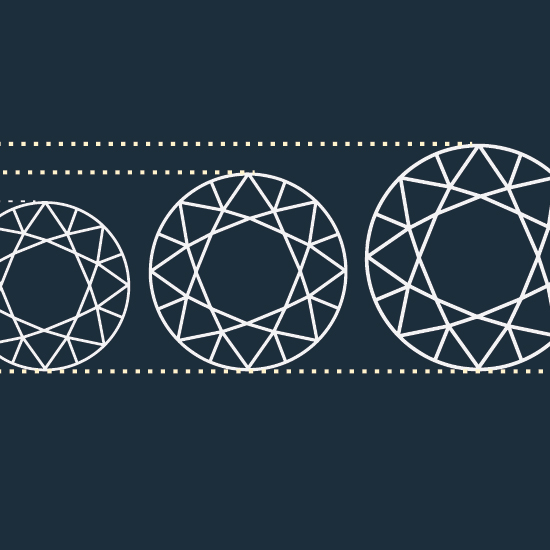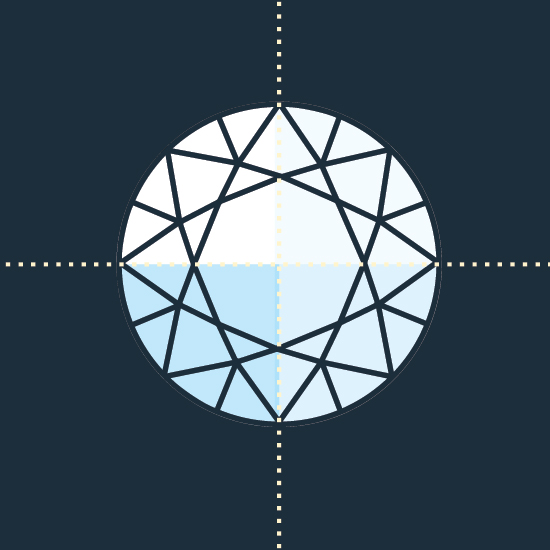RAPLAB® Grading Criteria
The 4 C's are part of a well-known grading system for evaluating diamonds by grading the carat weight,
color, clarity and cut. RAPLAB® grades diamonds based on the 4 C's and several additional criteria using sophisticated
technology to provide you with a more detailed and informative certification.
The 4 C's are part of a well-known grading system for evaluating diamonds by grading the carat weight,
color, clarity and cut. RAPLAB® grades diamonds based on the 4 C's and several additional criteria using sophisticated
technology to provide you with a more detailed and informative certification.
The 4 C's are part of a well-known grading system for evaluating diamonds by grading the carat weight,
color, clarity and cut. RAPLAB® grades diamonds based on the 4 C's and several additional criteria using sophisticated
technology to provide you with a more detailed and informative certification.

Carat Weight
Carat weight is the standard mass unit for diamonds and other gemstones. The word “carat” comes from the old Greek word for the seed of
a carob tree,
“kerátion” (κερατιον). It is important to note the difference between Carat – denoting the weight of gemstones;
and Karat – denoting the purity of gold alloys.
One metric carat is equal to 200 mg (0.2 g or 0.007055 oz.). In order to improve accuracy, we divide the carat to 100 points.
For example, a diamond of 55
points weighs 0.55 carats.

Color
You can find diamonds in every known color, including blue, green, brown and black. Colored diamonds are known as fancy stones
and are very rare. In fact,
only 0.001 percent of all diamonds are colored stones.
Grading Color
The most common diamonds are colorless-white to yellow or brown stones. The color is defined by the colors of the light rays that
pass through the stone.
Learn more

Clarity
The Clarity grade labels the diamond for the presence and severity of flaws. No diamond is 100% perfect. With enough magnification
you can find a flaw in
the cleanest stone.
Diamonds are created in the subterranean pressure of the Lithosphere. Under these extreme conditions, some alien elements like air
bubbles may become
trapped in the diamond. Other flaws can originate while cutting and polishing the stone.
Learn more

Cut
Cut identifies how closely the diamond has been cut and polished to ideal proportions.
A diamond's cut is not only about its shape, but how effectively the stone can return light back to the viewer's eye.
A well-cut diamond will be seen as brilliant
and sparkling. A poorly cut diamond may have the highest color and perfect
clarity yet it will look dark and lifeless.
Learn more

Polish
The quality of a diamond`s polish can affect the way light enters, and is refracted from, the stone. Polishing removes
unwanted material by gradual
erosion. After polishing, the diamond is re-examined for possible flaws, either remaining
or induced by the polishing process.
Learn more

Symmetry
Symmetry refers to the exactness of the shape and arrangement of facets in a diamond. Although to the naked eye polish
has only a small effect
on appearance, symmetry has a significant effect.
Learn more

Shape
There are nearly 2,000 different diamond shapes, with the round brilliant cut being most common.
Learn more

Treatments
Various ways of “treating” a diamond, such as heat, can be used to enhance the colorlessness of a diamond or intensify
the color of fancy colored
diamonds. The results of these treatments can produce temporary or permanent results.
However, treated stones are worth far less per
carat than natural stones.
Learn more

Fluorescence
One diamond out of three responds with fluorescence glow if exposed to ultraviolet (UV) rays. The strength, intensity and
color of the fluorescence are
different for each stone. Just 10 percent of all stones have a steady, strong fluorescence.
Learn more